This purpose of this article is to inform citrus growers about an exotic disease that has the potential to occur and spread in Florida’s citrus groves. Early detection will be key to handling this situation if it occurs; therefore, it is important to introduce growers to this possible threat ahead of its arrival. The target audience is the Florida citrus industry.
Citrus is susceptible to a large number of diseases caused by fungal, bacterial, and viral plant pathogens. Economic losses due to plant diseases can be severe, but fortunately, not all pathogens attacking citrus are found in Florida. Citrus diseases exotic to Florida are infectious citrus diseases that normally do not occur in Florida, either because they have never been introduced or present here or because they were eradicated. Any exotic disease, if introduced, may further increase production costs and decrease profitability for Florida growers. Exotic diseases will affect the viability of the industry and the varieties that could be profitably grown. For example, once considered an exotic disease, huanglongbing (HLB) was first found in Florida in 2005 and now is endemic in the state. HLB disease has been and still is an agent of destruction to the citrus industry, with tremendous yield loss, tree decline, and tree death. The economic damage that HLB has had on the industry is due to yield loss and very high production costs for spray and nutritional programs. This document is one in a series designed to provide important information on the causal agent, symptoms, and transmission of exotic citrus diseases. This information can be used as an educational tool to raise awareness about these diseases and for scouting and identification efforts. Disseminating information about the diseases to the citrus industry may prevent their introduction and spread in Florida. This document will focus on the exotic viral disease caused by isolates of citrus tristeza virus–stem pitting (CTV-SP).
Why are we concerned about CTV-SP in Florida?
Florida growers are familiar with the citrus tristeza virus (CTV) induced quick decline of trees on sour orange rootstocks. Sour orange was once the most popular rootstock used in Florida, until it was found to be highly susceptible to CTV quick-decline disease. Growers are less familiar with the stem-pitting disease caused by another certain isolate (originally isolated from an infected Valencia tree in Israel) of CTV, called VT isolate (Hilf et al. 2005). CTV-SP symptoms are found in many countries in Asia, Australia, South Africa, Brazil, and Colombia. Unlike quick decline, CTV-SP is not a bud-union disorder and can affect sensitive scion varieties regardless of the rootstock used. However, the rootstock can impact the severity of the stem-pitting disease expression. In Brazil, stem pitting on the rootstock of certain scion/rootstock combinations increased the severity of the disease (Müller et al. 1996). CTV-SP is a debilitating disease on grapefruit and sweet orange and may take years after infection before trees show obvious loss of vigor and yield. However, once infected the effect is continuous, and long-term economic effects to the grower may be worse than those from other CTV declines. For example, if trees are lost to CTV quick decline, they can be replaced with trees on tolerant rootstocks, and production is restored in a few years. Currently, there are no CTV-SP-tolerant grapefruit or sweet orange. However, once CTV-SP is endemic in an area, “resets” will soon become infected, and the debilitation cycle is repeated. Mild and decline-inducing isolates of CTV are already widespread in Florida, and VT isolates that induce mild to moderate CTV-SP in grapefruit and sweet orange were reported in a survey of commercial citrus in 2004 (Sieburth and Nolan 2005) and are still present in surveys conducted between 2018–2020 (Levy, Sieburth, and Batuman, unpublished results). Therefore, vigilance should be maintained in Florida.
What is the causal agent of CTV-SP disease?
CTV-SP is caused by certain severe isolates of Citrus tristeza virus and is found in the phloem of the plant. CTV is a member of the Closterovirus group of plant viruses with long, flexuous, rod-shaped particles. CTV is the largest plant RNA virus that has been characterized. There is extensive genetic diversity among various isolates of CTV, and many genetic groups of the virus have been found. Variability also exists within each group. The specific regions of the virus genome that are associated with the induction of stem pitting and how the interactions between the regions function are reviewed and explained by Dawson et al. (2013).
Which cultivars are affected by CTV-SP?
Citrus cultivars and relatives, even within the same group, tend to exhibit variable reactions to CTV infection. Limes, grapefruit, and alemow (Citrus macrophylla) are highly susceptible to CTV-SP. Sweet oranges and rough lemon are tolerant to many CTV isolates but show strong stem pitting when infected by CTV-SP. Mandarins are considered tolerant, but a mandarin stem-pitting isolate is found in parts of the Far East. Trifoliate orange and their hybrids carrying the CTV-resistance gene are resistant to CTV infection and CTV-SP, but hybrids without this gene may show strong pitting. Some pummelos show selective resistance specific to some severe CTV-SP isolates but are highly susceptible to others. It appears that several independent virus factors cause stem pitting in different hosts. Tristeza-induced stem pitting and decline are also apparently under separate genetic control. Decline isolates often do not cause stem pitting, and some CTV-SP isolates do not cause decline or seedling yellows (another symptom associated with decline isolates of CTV).
What are the typical symptoms caused by CTV-SP?
The severity of symptoms can vary greatly between isolates of CTV and citrus cultivar. For example, the cultivar Pera sweet orange is very susceptible to CTV-SP isolate in Brazil, but not to the Florida isolate. The virus symptoms can be observed by removing the bark of the stems (Figures 1–2). Sometimes only a few scattered pits can be seen after removing the bark from affected plants, and there is no detectable effect on plant vigor. Other isolates may cause extensive pits in the trunk and branches that can often be detected as depressed areas in the bark (Figure 3). When severe, the trunk and branches may have a ropy appearance (Figure 4). Trees may continue to grow fairly vigorously for extended periods with this type of pitting, but fruit size may be reduced. The most severe type of stem pitting causes extensive disruption in the normal differentiation of cambial cells into wood and bark. Affected twigs are brittle, and the bark is abnormally thick. Leaves are often chlorotic, and dieback may occur. Overall, the growth of the trees (on any rootstock) is markedly reduced. Fruits are frequently small and misshapen (Figure 5).
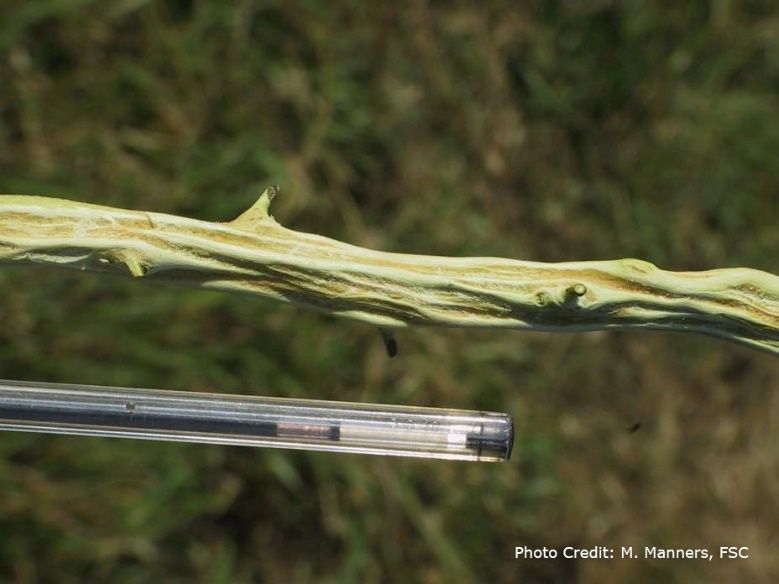
Credit: M. Manners, FSC
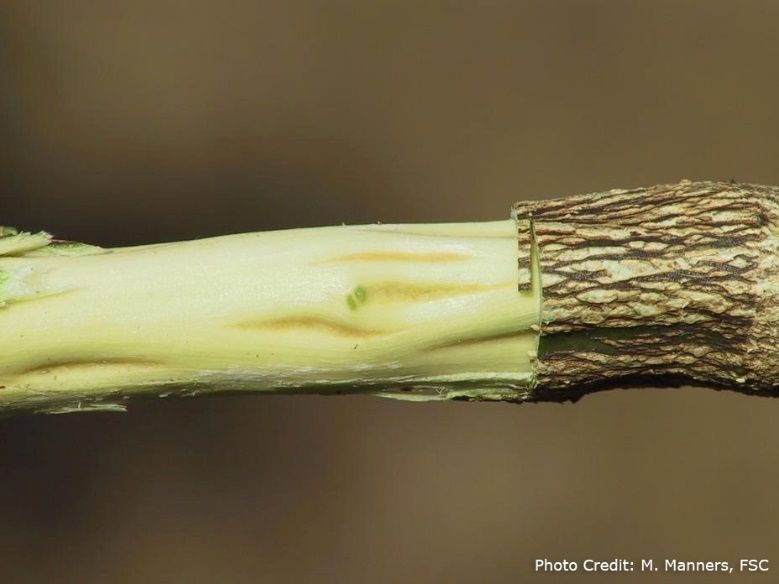
Credit: M. Manners, FSC
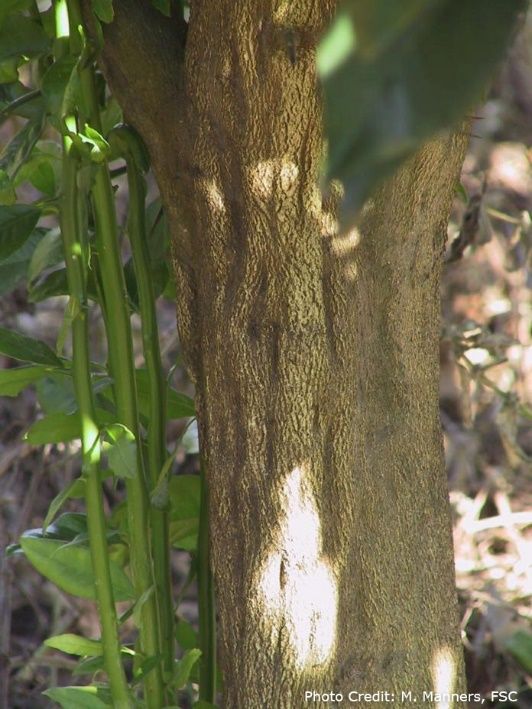
Credit: M. Manners, FSC
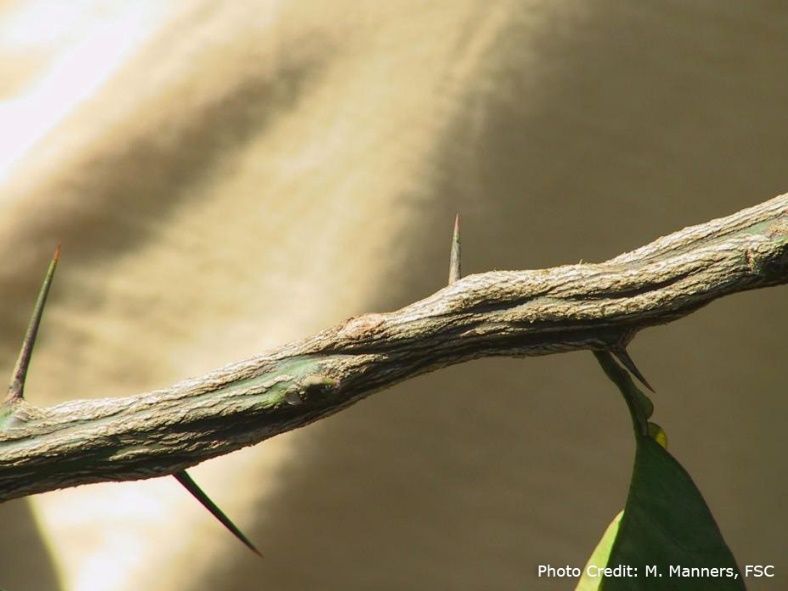
Credit: M. Manners, FSC
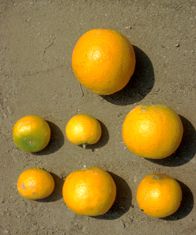
Credit: Richard Lee
How is CTV-SP transmitted?
As with decline isolates, CTV-SP isolates can be transmitted by budding and grafting, which is prevented by the mandatory Citrus Nursery Stock Certification Program (https://www.flrules.org/gateway/ChapterHome.asp?Chapter=5B-62) in Florida. Long-distance movement of CTV-SP to different countries or different areas within a region is usually via the movement of the infected budwood or nursery stock. CTV-SP is also transmitted by several species of aphids. The brown citrus aphid (Toxoptera citricida) (Figure 6) is considered the most efficient vector, but the melon aphid (Aphis gossypii) and the spirea aphid (A. spiraecola) can also transmit the CTV-SP virus. The patterns of spread vary according to the type of aphids involved. CTV-SP isolates are transmitted more effectively by brown citrus aphid as compared to other aphids and also when CTV-SP cannot be detected in the donor host (Brlansky et al. 2011). A CTV-SP problem often increases rapidly after the brown citrus aphid becomes established in a new area. The brown citrus aphid and other aphid species are present in Florida. This increases the potential for the spread of CTV-SP in Florida. CTV cannot be easily transmitted by mechanical inoculation into citrus plants, and thus, natural transmission by contaminated tools in the field is unlikely.
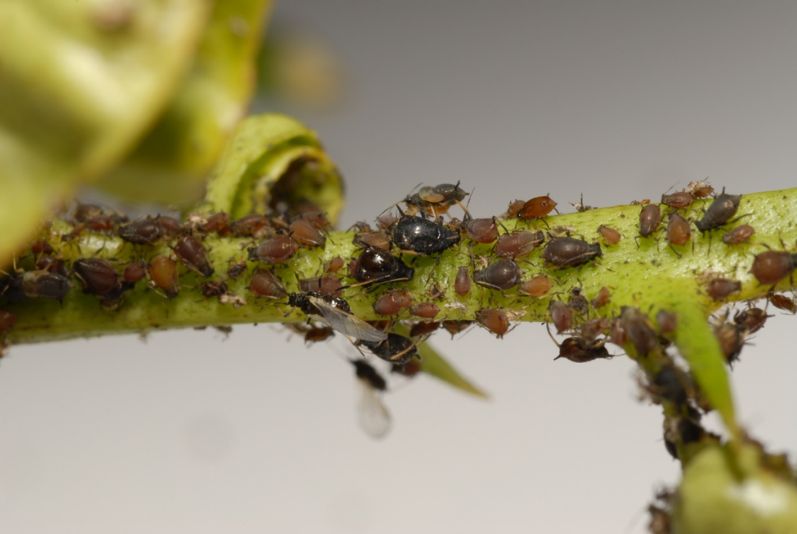
Credit: Lyle Buss, UF insect ID lab
How can CTV-SP be detected?
CTV-SP can be readily identified by looking for pits in the trunk and branches in the field. However, both sweet orange and grapefruit trees can harbor a stem-pitting CTV isolate but may not show any symptoms. For confirmation of infection, bioassay and molecular detection must be performed. CTV-SP isolates can be detected by inoculation of specific susceptible cultivars, a technique known as biological indexing. For example, Duncan grapefruit seedlings are used to detect grapefruit CTV-SP, and Madam Vinous is commonly used to detect sweet orange CTV-SP isolates. Most CTV-SP isolates react to the MCA13 monoclonal antibody used in Florida to detect severe CTV isolates. However, MCA13 cannot separate decline isolates from CTV-SP isolates. Three published methods for discrimination of CTV-SP from other isolates of CTV were tested on a series of CTV isolates from a Floridian and an international collection previously characterized by biological indexing for CTV-SP (Hilf et al. 2005). One method involved hybridization with molecular probes, and the other two used sets of reverse transcriptase (RT)-PCR primers. Because of the complexity of CTV stem-pitting disease and diversity of the virus, no one technique could detect all the CTV-SP isolates (Sieburth et al. 2005). Six groups of markers are used to characterize CTV populations: T-30 (mild), T-36 (decline), RB (CTV-resistance breaking), VT, T3, and T-68 (these last three can contain severe isolates causing stem-pitting symptoms) (Matos et al. 2013).
How can CTV-SP be controlled?
The first lines of defense in areas where CTV-SP is not yet present or widespread are quarantine and budwood certification programs. Eradication may be an option under certain circumstances where the initial infection is limited and resources are immediately available to detect and remove infected trees. There are no commercial cultivars of limes, lemons, grapefruit, or sweet orange with acceptable levels of tolerance to CTV-SP isolates. A resistance gene has been identified in trifoliate orange, but incorporation of this source of resistance by breeding or genetic engineering remains a long-term proposition, in part because of the time required to verify horticultural characteristics of new germplasm. Mild-strain cross-protection against CTV has been used with some success in Brazil, South Africa, and Australia to alleviate losses, but protecting mild isolates must be very similar to the severe isolates to give good cross-protection, and this similarity can change over time. Cross-protection is specific to the geographic area (Folimonova et al. 2020). The Florida VT isolates found previously (Sieburth and Nolan 2005) were studied further, and a milder VT isolate that did not cause stem-pitting symptoms was able to protect against other related Florida VT isolates causing more severe stem-pitting symptoms (Hilf et al. 2007).
The ability to engineer improved CTV “protecting isolates” tailored to specific cross-protection requirements is still years away. Often the only practical option is to avoid growing cultivars sensitive to CTV stem pitting. Vector control will slow but not prevent the spread of insect-vectored pathogens.
What can growers do?
CTV-SP is a vector-borne disease. Control of CTV-SP is difficult if inoculum sources are widespread and the aphid vectors are well established. Removing infected trees and keeping aphid populations in check in the grove may help reduce secondary spread of the virus onto resets. Once the virus is established, it will be difficult to stop by chemical or biological control of the aphid, because much of the acquisition and transmission of the virus by the aphid occurs before the aphid is killed by an insecticide. However, rigorous aphid control in nurseries and on budwood-source trees could reduce infection rates. Undoubtedly, the best means of preventing CTV-SP is to always use clean, healthy trees from registered nurseries. It is important to avoid bringing propagation materials from CTV-SP-infected areas to Florida. Any citrus propagating materials must be introduced by proper procedures through the Florida Department of Agriculture and Consumer Services (FDACS), Division of Plant Industry (DPI; https://www.fdacs.gov/Agriculture-Industry/Pests-and-Diseases/Plant-Pests-and-Diseases/Citrus-Health-Response-Program). Growers noticing stem pitting in their trees should contact their local citrus Extension agents (https://citrusagents.ifas.ufl.edu/) or DPI (1-800-282-5153).
Selected References
Bar-Joseph, M., O. Batuman, and C. N. Roistacher. 2009. “The History of Citrus Tristeza Virus: Revisited.” In Citrus Tristeza Virus Complex and Tristeza Diseases, edited by A. V. Karasev and M. E. Hilf, 3–26. St. Paul: APS Press.
Bar-Joseph, M., R. Marcus, and R. F. Lee. 1989. “The Continuous Challenge of Citrus Tristeza Virus Control.” Annual Review of Phytopathology 27:291–316. https://doi.org/10.1146/annurev.py.27.090189.001451
Brlansky, R. H., A. Roy, and V. D. Damsteegt. 2011. “Stem-pitting Citrus tristeza virus Predominately Transmitted by the Brown Citrus Aphid from Mixed Infections Containing Non-stem-pitting and Stem-pitting Isolates.” Plant Dis. 95 (8): 913–920. https://doi.org/10.1094/PDIS-10-10-0772
Dawson, W. O., M. Bar-Joseph, S. M. Garnsey, and P. Moreno. 2015. “Citrus Tristeza Virus: Making an Ally from an Enemy.” Annual Review of Phytopathology 53:137–155. https://doi.org/10.1146/annurev-phyto-080614-120012
Dawson, W. O., S. M. Garnsey, T. S. Tatineni, S. Y. Folimonova, S. J. Harper, and S. Gowda. 2013. “Citrus Tristeza Virus–Host Interactions.” Front. Microbiol. 4:88. https://doi.org/10.3389/fmicb.2013.00088
Folimonova, S. Y., D. Achor, and M. Bar-Joseph. 2020. “Walking Together: Cross-Protection, Genome Conservation, and the Replication Machinery of Citrus tristeza virus.” Viruses 12 (12): 1353. https://doi.org/10.3390/v12121353
Garnsey, S. M., T. R. Gottwald, and R. K. Yokomi. 1998. “Control Strategies for Citrus tristeza virus.” In Plant Virus Disease Control, edited by A. Hadidi, R. Khetarpal, and H. Kozanezawa, 639–658. St. Paul: APS.
Hilf, M., S. Garnsey, C. Robertson, S. Gowda, T. Satyanarayana, M. Irey, P. Sieburth and W. Dawson. 2007. “Characterization of Recently Introduced HLB and CTV Isolates.” Proc. Fla. Hort. Soc. 120:138–141.
Hilf, M. E., V. A. Mavrodieva, and S. M. Garnsey. 2005. “Genetic Marker Analysis of a Global Collection of Isolates of Citrus tristeza virus: Characterization and Distribution of CTV Genotypes and Association with Symptoms.” Phytopathology 95 (8): 909–917. https://doi.org/10.1094/PHYTO-95-0909
Matos, L. A., M. E. Hilf, X. A. Cayetano, A. O. Felix, S. J. Harper, and S. Y. Folimonova. 2013. “Dramatic Change in Citrus tristeza virus Populations in the Dominican Republic.” Plant Dis. 97 (3): 339–345. https://doi.org/10.1094/PDIS-05-12-0421-RE
Müller, G. W., N. Guirado, J. O. de Figueiredo, M. A. Machado, F. F. Laranjeira, and J. L. de Castro. 1996. “Citrus Tristeza Virus Causes Stem Pitting in Rangpur Lime Rootstock Grafted with Some Mandarin Cultivars in Capao Bonito, Brazil.” Proc. 13th Conf. Int Org. Citrus Virologists 13 (13): 325–328. https://doi.org/10.5070/C545F2Z4R4
Rocha-Peña, M. A., R. F. Lee, R. Lastra, C. L. Niblett, F. M. Ochoa-Corona, S. M. Garnsey, and R. K. Yokomi. 1995. “Citrus Tristeza Virus and Its Aphid Vector Toxoptera citricida.” Plant Disease 79:437–445. https://doi.org/10.1094/PD-79-0437
Roistacher, C. N., and P. Moreno. 1991. “The Worldwide Threat from Destructive Isolates of Citrus Tristeza Virus—A Review.” Proceedings of the 11th Conference International Organization of Citrus Virology 11 (11): 7–19. https://doi.org/10.5070/C568S8K9TX
Sieburth, P. J., and K. G. Nolan. 2005. “Survey of Stem Pitting Citrus Tristeza Virus in Commercial Citrus Groves in Florida.” Proc. Fla. State Hort. Soc. 118:40–42.
Sieburth, P. J., K. G. Nolan, M. E. Hilf, R. F. L. Lee, P. Moreno, and S. M. Garnsey. 2005. “Discrimination of Stem-pitting from Other Isolates of Citrus tristeza virus.” Proceedings of the 16th Conference International Organization of Citrus Virologists 16 (16): 1–10. https://doi.org/10.5070/C521K789P6